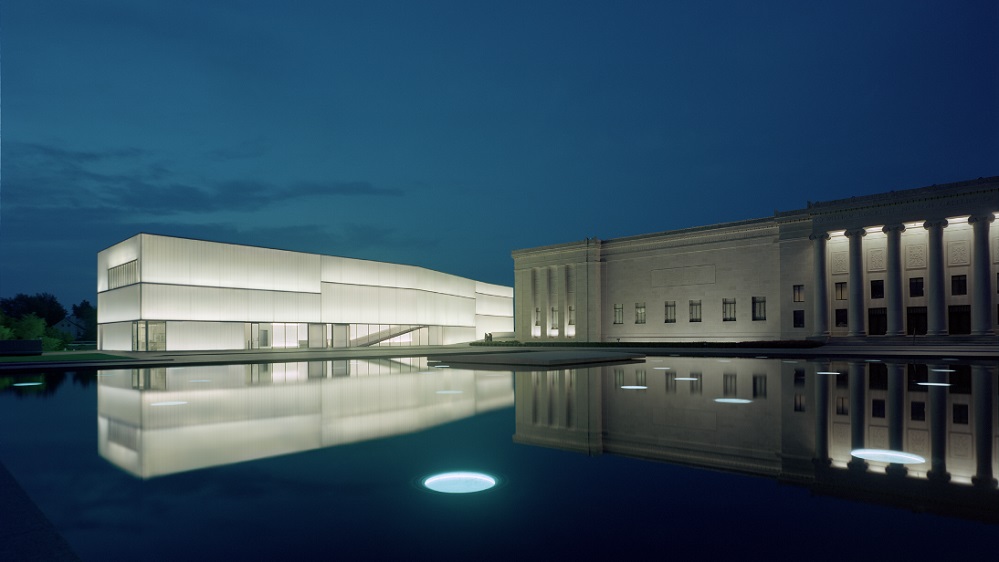JUNE 15, 2017 8:30 PM
BY STEVE MCDOWELL
Special to The Star
This year marks 10 years since a unique moment of international attention was bestowed upon Kansas City. On a sunny day in June 2007, Henry Bloch and others were hoisted into the air in the bucket of a construction lift to celebrate the opening of the Bloch Building expansion at the Nelson-Atkins Museum of Art.
In retrospect, this new building and the decisions leading to the selection of its architect, Steven Holl, for a commission far different from his past portfolio were a result of true civic leadership and vision.
Don and Adele Hall, Morton and Estelle Sosland and Henry and Marion Bloch listened to then-museum director Marc Wilson and his provocative advice and counsel and moved forward with this building that would change the world and Kansas City, too.
Steven Holl and his partner Chris McVoy skillfully imagined a glass building that complemented the original neo-classical stone landmark with grace. Their concept of complements, termed “the stone and the feather,” paid homage and protected the presence of the existing 1933 edifice designed by the Kansas City firm of Wight and Wight.
More importantly, they imagined a series of ever-changing experiences that have now opened all of our senses and intellectual channels to allow us to appreciate each artwork both individually and collectively. In this remarkable project, the whole is much greater than the sum of the parts.
Holl and McVoy were chosen after an international competition. They broke the rules with this counterintuitive design. The first move entailed ignoring the competition brief stating that the site for the expansion was to be the north lawn, which would have dramatically altered the presence of the original structure. Next, they placed priceless art in galleries located underground, with carefully integrated daylight harvested by lenses punctuating the landscape.
Today, the transformation of the 1933 building continues into equally compelling galleries and additional facilities, most recently with the opening of the Bloch Galleries that integrate 28 impressionist paintings gifted by Henry and Marion Bloch to the museum. This museum, right here in Kansas City, continues to be a living ecosystem for experiencing art.
The Bloch Building has frankly been instrumental in the explosion of one of the most important and vibrant arts communities in the country.
If we look back decades or more we would recall the time that Marc Wilson was working with the Nelson’s trustees to imagine the possibilities of an expansion to house the museum’s growing collection. The times and city were fertile for something to happen. Kansas City as an art experience was just beginning to sprout.
The Kemper Museum had recently opened as part of the Kansas City Art Institute. The Crossroads was in its infancy, and artists were the main inhabitants of the mostly abandoned warehouses. The Kauffman Center was an idea but lacked a site or a clear vision. Charlotte Street was new organization, founded in 1997.
The Symphony, Ballet and Lyric Opera were sharing the Lyric Theatre, and the Nerman Museum did not yet exist. The Kansas City Ballet lacked a permanent home at all, and the H&R Block Art Space was not yet on the radar.
Kansas City has dramatically changed. Today we are proudly an arts city. We are home to an arts experience that continues to evolve, becoming increasingly more powerful across the global arts world. And the 10-year-old Bloch Building, once a celebrated innovation, is now an important part of the legacy of Kansas City’s transformation.
As all living organisms evolve and change to support their ecosystems, the same is true of the Nelson-Atkins Museum and of our vibrant arts collective as a whole. It is now museum director Julian Zugazagoitia who is charting the path for keeping the vibrancy of art experiences alive and continuing the transformation of Kansas City and the world. What will be next?
Steve McDowell is president and CEO of BNIM.
Photo credit: Tim Hursley
